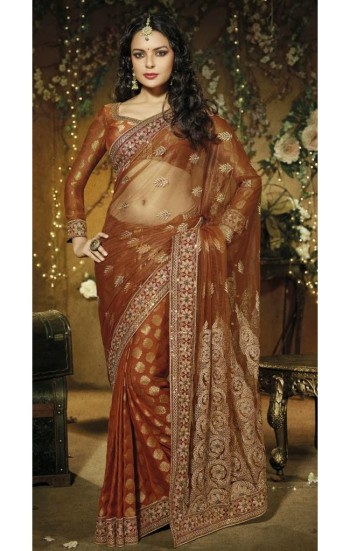Source(google.com.pk)
The word 'sari' is believed to derive from the Sanskrit word 'sati', which means strip of cloth. This evolved into the Prakrit 'sadi' and the sound later decayed into 'sari'.
Some versions of the history of Indian clothing trace the sari back to the Indus valley civilization, which flourished in 2800-1800 BCE. One ancient statue shows a man in a draped robe which some sari researchers believe to be a precursor of the sari.
Ancient Tamil poetry, such as the Silappadhikaram and the Kadambari by Banabhatta, describes women in exquisite drapery. This drapery is believed to be a sari. In the Natya Shastra (an ancient Indian treatise describing ancient dance and costumes), the navel of the Supreme Being is considered to be the source of life and creativity. Hence the stomach of the dancer is to be left unconcealed, which some take to indicate the wearing of a sari.
Some costume historians believe that the men's dhoti, which is the oldest Indian draped garment, is the forerunner of the sari. They say that until the 14th century, the dhoti was worn by both men and women.
Sculptures from the Gandhara, Mathura and Gupta schools (1st-6th century CE) show goddesses and dancers wearing what appears to be a dhoti wrap, in the "fishtail" version which covers the legs loosely and then flows into a long, decorative drape in front of the legs. No bodices are shown.
Other sources say that everyday costume consisted of a dhoti or lungi (sarong), combined with a breast band and a veil or wrap that could be used to cover the upper body or head. Some argue that the two-piece Kerala mundum neryathum (mundu in malayalam is the same as dhoti or sarong and neryath means a cloth to cover the upper body similar to a shawl) is a survival of ancient Indian clothing styles, and that the one-piece sari is a modern innovation, created by combining the two pieces of the mundum neryathum.
It is generally accepted that wrapped sari-like garments, shawls, and veils have been worn by Indian women for a long time, and that they have been worn in their current form for hundreds of years.
One point of particular controversy is the history of the choli, or sari blouse, and the petticoat. Some researchers state that these were unknown before the British arrived in India, and that they were introduced to satisfy British ideas of modesty. Previously, women only wore the one, draped cloth and casually exposed the upper body and breasts. Other historians point to much textual and artistic evidence for various forms of breastband and upper-body shawl.
It is possible that the researchers arguing for a recent origin for the choli and the petticoat are extrapolating from South India, where it is indeed documented that in some areas, women wore only the sari and exposed the upper part of the body. Poetic references from works like Shilappadikaram indicate that during the sangam period in ancient South India, a single piece of clothing served as both lower garment and head covering, leaving the bosom and midriff completely uncovered. In Kerala there are many references to women being topless, including many pitcures by Raja Ravi Varma. Even today, women in some rural areas do not wear cholis. Though the origin of sari is a bit obscure, we are sure that ancient Indian women were using long and wide cloths to drape their body, gleaned from legends in ancient manuscripts such as the Vedic Scripts, Mahabharata, Silappadhikaram, Kadambari and Natya Shastra. This texts date back to approximately 1500 to 500 BC. Many scholars believe the earliest texts date back 5000 years!
The word sari itself is a corrupted version of Sanskrit word ‘sati’ which means ‘strip of cloth’. Silappadhikaram and the Kadambari an ancient Tamil poetry , describes women in exquisite drapery or sari. While the Natya Shastra- an ancient Indian treatise describing ancient dance and costumes, states that the navel of the Supreme Being is considered to be the source of life and creativity, hence the midriff is to be left bare by the sari. Sari or sari like long dress is also mentioned in the world longest epic Mahabharata. The legend has it that when the Pandavas lost their wife Draupadi to the enemy clan in a gambling duel, the victors caught one end of her sari and continued to pull and unravel, but could reach no end.
Beautiful Indian Sarees Indian Sarees 2014 Designs Online For Kids Images Design Patterns Online Shopping Wedding Blouse Designs










No comments:
Post a Comment